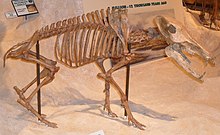| Mylohyus Temporal range: Pliocene - Early Holocene, 5–0.009 Ma PreꞒ Ꞓ O S D C P T J K Pg N ↓ | |
|---|---|

| |
| M. nasutus, Texas Science & Natural History Museum | |
| Scientific classification | |
| Domain: | Eukaryota |
| Kingdom: | Animalia |
| Phylum: | Chordata |
| Class: | Mammalia |
| Order: | Artiodactyla |
| Family: | Tayassuidae |
| Genus: | †Mylohyus Cope, 1869 |
| Species | |
| |

Mylohyus is an extinct genus of peccary found in North and Central America. It first evolved during the Late Miocene and became extinct at the end of the Pleistocene, around 12,000 years ago, during the Late Pleistocene megafaunal extinction.
Six species were known, the most famous being Mylohyus nasutus, also known as the long-nosed peccary. It went extinct at the end of the Rancholabrean North American Land Mammal Age. The genus was slightly larger-bodied than any modern peccaries, with an estimated mass of 68 kg (150 lb).
Isotope and anatomical studies have suggested that the diet of Mylohyus varied over geological time, from being primarily a C3 browser during the Blancan, with an increasing consumption of C4 vegetation during the Irvingtonian, with a relatively even mixture of C3 and C4 during the Rancholabrean. Suggestions have been made that it was frugivorous and also consumed hard browse like twigs. Mylohyus was able to coexist with close phylogenetic relatives because of efficient niche partitioning between it and other genera of peccaries.
Description
The long-nosed peccary was about 0.75 metres (2.5 ft) in height and 67 kilograms (148 lb) in weight. It had an elongated face, long, thin legs and dewclaws.
Habitat and distribution
During the last glacial, long-nosed peccaries, sensu lato, were distributed throughout southeastern North America with concentrations in Appalachia and Florida. Most fossil localities containing this species are found in the southern and south-eastern U.S., from west Texas to Florida, and north to Pennsylvania. Mylohyus nasutus, if considered to be a different species than M. fossilis, occupied the western part of this range, but their classification as separate species is disputed. According to Lundelius, these species or forms co-occur in the Cumberland Cave deposits in Maryland.
Ecology and behavior
Unlike the flat-headed peccary, Platygonus compressus, the long-nosed peccary was probably a solitary animal and did not frequent caves.
Sources
- ^ Nye, April Season (2007). Pleistocene Peccaries from Guy Wilson Cave, Sullivan County, Tennessee (MS thesis). East Tennessee State University. Paper 2115. Retrieved 18 July 2024 – via Electronic Theses and Dissertations.
- The Paleobiology Database: Mylohyus
- Bradham, Jennifer L.; DeSantis, Larisa R.G.; Jorge, Maria Luisa S.P.; Keuroghlian, Alexine (June 2018). "Dietary variability of extinct tayassuids and modern white-lipped peccaries ( Tayassu pecari ) as inferred from dental microwear and stable isotope analysis". Palaeogeography, Palaeoclimatology, Palaeoecology. 499: 93–101. Bibcode:2018PPP...499...93B. doi:10.1016/j.palaeo.2018.03.020. S2CID 134099913. Retrieved 6 February 2024.
- DeSantis, Larisa R. G.; Feranec, Robert S.; MacFadden, Bruce J. (3 June 2009). Moen, Jon (ed.). "Effects of Global Warming on Ancient Mammalian Communities and Their Environments". PLoS ONE. 4 (6): e5750. Bibcode:2009PLoSO...4.5750D. doi:10.1371/journal.pone.0005750. ISSN 1932-6203. PMC 2684586. PMID 19492043.
- Mendoza, M.; Janis, C. M.; Palmqvist, P. (2006). "Estimating the body mass of extinct ungulates: a study on the use of multiple regression". Journal of Zoology. 270 (1): 90–101. doi:10.1111/j.1469-7998.2006.00094.x.
- Lundelius, Jr., E.L. (1961). "Mylohyus nasutus: Long-nosed Peccary of the Texas Pleistocene". Bulletin of the Texas Memorial Museum. 1. Retrieved 18 July 2024 – via Texas ScholarWorks, The University of Texas at Austin.
- Tankersley, Kenneth B. (2011). "Evaluating the Co-occurrence of Platygonus compressus and Mylohyus nasutus at Sheriden Cave, Wyandot County, Ohio" (PDF). Current Research in the Pleistocene. 28: 185–187. Retrieved 18 July 2024 – via Pleistocene Archives, Center for the Study of the First Americans, College of Liberal Arts at Texas A&M University.
External links
| Genera of peccaries, pigs and their extinct allies | |||||||||||||||||||||||||||||||||||
|---|---|---|---|---|---|---|---|---|---|---|---|---|---|---|---|---|---|---|---|---|---|---|---|---|---|---|---|---|---|---|---|---|---|---|---|
| |||||||||||||||||||||||||||||||||||
| |||||||||||||||||||||||||||||||||||
| |||||||||||||||||||||||||||||||||||
| Taxon identifiers | |
|---|---|
| Mylohyus | |
| Mylohyus nasutus | |
 | This prehistoric even-toed ungulate-related article is a stub. You can help Misplaced Pages by expanding it. |